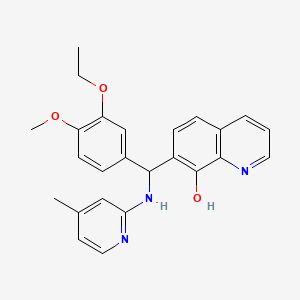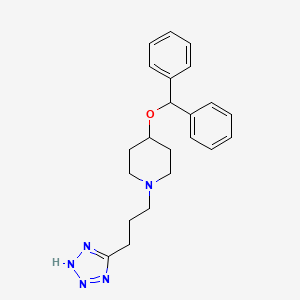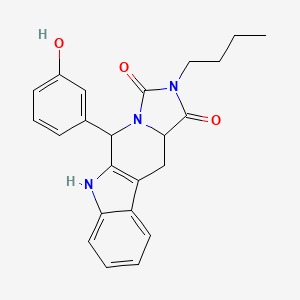
フルフェナジン
概要
説明
フルフェナジンは、フェノチアジン系に属する高力価の典型的な抗精神病薬です。主に統合失調症などの慢性精神病の治療に使用されます。 フルフェナジンは、脳内のドーパミン受容体を阻害することにより、精神病の症状を管理するのに役立ちます .
2. 製法
合成経路と反応条件: フルフェナジンは、複数段階のプロセスで合成されます。合成は、フルフェナム酸から出発して、脱炭酸反応と環化反応によって達成される2-トリフルオロメチルフェノチアジンの調製から始まります。この中間体は、次に1-(2-エトキシル)ピペラジンと1,3-ブロモクロロプロパンと反応させて、1-(3-クロロプロピル)-4-(2-エトキシル)ピペラジンを生成します。 最後に、これらの中間体の縮合反応によって、フルフェナジンが生成されます .
工業的生産方法: フルフェナジンの工業的生産には、同様の合成経路が用いられますが、規模が大きくなります。 このプロセスは、収量と純度を最適化するために、多くの場合、品質管理のために高速液体クロマトグラフィー(HPLC)が用いられます .
作用機序
フルフェナジンは、脳内のシナプス後視床下部-黒質ドーパミン神経路のD1およびD2受容体を遮断することによって、その効果を発揮します。 この作用は、視床下部や下垂体からのホルモンの放出を抑制し、網様体賦活系に影響を与え、基礎代謝、体温、覚醒、血管運動性、嘔吐に影響を与えます .
類似の化合物:
クロルプロマジン: 使用法は類似していますが、効力が低いフェノチアジン系抗精神病薬。
ハロペリドール: 化学構造は異なりますが、治療効果が類似している高力価の抗精神病薬。
ペルフェナジン: 効果は同等ですが、副作用のプロフィールが異なるフェノチアジン系抗精神病薬
フルフェナジンの独自性: フルフェナジンは、その高力価と長効性注射製剤により、持続的な治療効果を提供し、患者のコンプライアンスを向上させるという独自の特性を持っています .
科学的研究の応用
Fluphenazine has a wide range of scientific research applications:
Chemistry: Used as a model compound in studying the behavior of phenothiazines.
Biology: Investigated for its effects on cellular processes and signaling pathways.
Medicine: Primarily used in the treatment of schizophrenia and other psychotic disorders.
Industry: Utilized in the development of long-acting injectable formulations for sustained drug delivery.
生化学分析
Biochemical Properties
Fluphenazine interacts with various biomolecules in the body. It primarily blocks postsynaptic mesolimbic dopaminergic D1 and D2 receptors in the brain . By doing so, it depresses the release of hypothalamic and hypophyseal hormones . This interaction affects basal metabolism, body temperature, wakefulness, vasomotor tone, and emesis .
Cellular Effects
Fluphenazine has significant effects on various types of cells and cellular processes. It influences cell function by affecting cell signaling pathways, gene expression, and cellular metabolism . For instance, it can cause serious side effects, particularly movement disorders, and is known to lower people’s mood .
Molecular Mechanism
Fluphenazine exerts its effects at the molecular level through several mechanisms. It blocks dopamine receptors, primarily D1 and D2 . This blockade depresses the release of hypothalamic and hypophyseal hormones, which in turn affects various physiological processes .
Temporal Effects in Laboratory Settings
In laboratory settings, the effects of Fluphenazine can change over time. For instance, in rat models, Fluphenazine and its metabolites were detected in tissues at higher levels than in plasma, and the levels increased with dose .
Dosage Effects in Animal Models
In animal models, the effects of Fluphenazine vary with different dosages. For example, systemic Fluphenazine effectively attenuated mechanical allodynia in rat neuropathic pain models at doses (0.03–0.3 mg/kg) that approximate those used in rodent models of psychosis .
Metabolic Pathways
Fluphenazine is involved in various metabolic pathways. The metabolism of Fluphenazine is complex. It is metabolized extensively by aromatic hydroxylation, S- and N-oxidation, N-desalkylation, and glucuronidation .
Transport and Distribution
Fluphenazine is transported and distributed within cells and tissues. In rat models, Fluphenazine was found to be 10- to 27-fold higher in brain regions than in plasma . Liver contained the highest levels of all analytes at all doses .
Subcellular Localization
It is known that Fluphenazine and its metabolites are detected in tissues at higher levels than in plasma, indicating that it may be localized in specific subcellular compartments .
準備方法
Synthetic Routes and Reaction Conditions: Fluphenazine is synthesized through a multi-step process. The synthesis begins with the preparation of 2-trifluoromethyl phenothiazine, which is achieved by decarboxylation and cyclization reactions starting from flufenamic acid. This intermediate is then reacted with 1-(2-ethoxyl)piperazine and 1,3-bromochloropropane to form 1-(3-chloropropyl)-4-(2-ethoxyl)piperazine. Finally, a condensation reaction between these intermediates yields fluphenazine .
Industrial Production Methods: Industrial production of fluphenazine involves similar synthetic routes but on a larger scale. The process is optimized for yield and purity, often involving high-performance liquid chromatography (HPLC) for quality control .
化学反応の分析
反応の種類: フルフェナジンは、以下を含むさまざまな化学反応を起こします。
酸化: フルフェナジンは、特定の条件下で酸化され、分解生成物が生成されます。
還元: 還元反応は、フルフェナジンの官能基を修飾し、その薬理学的特性を変更する可能性があります。
一般的な試薬と条件:
酸化: 過酸化水素などの酸化剤を制御された条件下で使用します。
還元: 水素化リチウムアルミニウムなどの還元剤。
置換: ハロゲン基を導入または修飾するためのハロゲン化剤。
生成される主要な生成物: これらの反応から生成される主要な生成物には、さまざまな類似体や分解生成物が含まれ、LC-MS / MSなどの技術を使用して特徴付けることができます .
4. 科学研究への応用
フルフェナジンは、幅広い科学研究への応用を持っています。
類似化合物との比較
Chlorpromazine: Another phenothiazine antipsychotic with similar uses but lower potency.
Haloperidol: A high-potency antipsychotic with a different chemical structure but similar therapeutic effects.
Perphenazine: A phenothiazine antipsychotic with comparable efficacy but different side effect profiles
Uniqueness of Fluphenazine: Fluphenazine is unique due to its high potency and long-acting injectable formulations, which provide sustained therapeutic effects and improve patient compliance .
特性
IUPAC Name |
2-[4-[3-[2-(trifluoromethyl)phenothiazin-10-yl]propyl]piperazin-1-yl]ethanol | |
|---|---|---|
| Source | PubChem | |
| URL | https://pubchem.ncbi.nlm.nih.gov | |
| Description | Data deposited in or computed by PubChem | |
InChI |
InChI=1S/C22H26F3N3OS/c23-22(24,25)17-6-7-21-19(16-17)28(18-4-1-2-5-20(18)30-21)9-3-8-26-10-12-27(13-11-26)14-15-29/h1-2,4-7,16,29H,3,8-15H2 | |
| Source | PubChem | |
| URL | https://pubchem.ncbi.nlm.nih.gov | |
| Description | Data deposited in or computed by PubChem | |
InChI Key |
PLDUPXSUYLZYBN-UHFFFAOYSA-N | |
| Source | PubChem | |
| URL | https://pubchem.ncbi.nlm.nih.gov | |
| Description | Data deposited in or computed by PubChem | |
Canonical SMILES |
C1CN(CCN1CCCN2C3=CC=CC=C3SC4=C2C=C(C=C4)C(F)(F)F)CCO | |
| Source | PubChem | |
| URL | https://pubchem.ncbi.nlm.nih.gov | |
| Description | Data deposited in or computed by PubChem | |
Molecular Formula |
C22H26F3N3OS | |
| Source | PubChem | |
| URL | https://pubchem.ncbi.nlm.nih.gov | |
| Description | Data deposited in or computed by PubChem | |
DSSTOX Substance ID |
DTXSID2023068 | |
| Record name | Fluphenazine | |
| Source | EPA DSSTox | |
| URL | https://comptox.epa.gov/dashboard/DTXSID2023068 | |
| Description | DSSTox provides a high quality public chemistry resource for supporting improved predictive toxicology. | |
Molecular Weight |
437.5 g/mol | |
| Source | PubChem | |
| URL | https://pubchem.ncbi.nlm.nih.gov | |
| Description | Data deposited in or computed by PubChem | |
Physical Description |
Solid | |
| Record name | Fluphenazine | |
| Source | Human Metabolome Database (HMDB) | |
| URL | http://www.hmdb.ca/metabolites/HMDB0014761 | |
| Description | The Human Metabolome Database (HMDB) is a freely available electronic database containing detailed information about small molecule metabolites found in the human body. | |
| Explanation | HMDB is offered to the public as a freely available resource. Use and re-distribution of the data, in whole or in part, for commercial purposes requires explicit permission of the authors and explicit acknowledgment of the source material (HMDB) and the original publication (see the HMDB citing page). We ask that users who download significant portions of the database cite the HMDB paper in any resulting publications. | |
Boiling Point |
268-274 °C at 5.00E-01 mm Hg, BP: 250-252 °C at 0.3 mm Hg; 268-274 °C at 0.5 mm Hg | |
| Record name | Fluphenazine | |
| Source | DrugBank | |
| URL | https://www.drugbank.ca/drugs/DB00623 | |
| Description | The DrugBank database is a unique bioinformatics and cheminformatics resource that combines detailed drug (i.e. chemical, pharmacological and pharmaceutical) data with comprehensive drug target (i.e. sequence, structure, and pathway) information. | |
| Explanation | Creative Common's Attribution-NonCommercial 4.0 International License (http://creativecommons.org/licenses/by-nc/4.0/legalcode) | |
| Record name | Fluphenazine | |
| Source | Hazardous Substances Data Bank (HSDB) | |
| URL | https://pubchem.ncbi.nlm.nih.gov/source/hsdb/3334 | |
| Description | The Hazardous Substances Data Bank (HSDB) is a toxicology database that focuses on the toxicology of potentially hazardous chemicals. It provides information on human exposure, industrial hygiene, emergency handling procedures, environmental fate, regulatory requirements, nanomaterials, and related areas. The information in HSDB has been assessed by a Scientific Review Panel. | |
Solubility |
In water, 31.1 g/L (31.3 mg/L) at 37 °C, 1.90e-02 g/L | |
| Record name | Fluphenazine | |
| Source | DrugBank | |
| URL | https://www.drugbank.ca/drugs/DB00623 | |
| Description | The DrugBank database is a unique bioinformatics and cheminformatics resource that combines detailed drug (i.e. chemical, pharmacological and pharmaceutical) data with comprehensive drug target (i.e. sequence, structure, and pathway) information. | |
| Explanation | Creative Common's Attribution-NonCommercial 4.0 International License (http://creativecommons.org/licenses/by-nc/4.0/legalcode) | |
| Record name | Fluphenazine | |
| Source | Hazardous Substances Data Bank (HSDB) | |
| URL | https://pubchem.ncbi.nlm.nih.gov/source/hsdb/3334 | |
| Description | The Hazardous Substances Data Bank (HSDB) is a toxicology database that focuses on the toxicology of potentially hazardous chemicals. It provides information on human exposure, industrial hygiene, emergency handling procedures, environmental fate, regulatory requirements, nanomaterials, and related areas. The information in HSDB has been assessed by a Scientific Review Panel. | |
| Record name | Fluphenazine | |
| Source | Human Metabolome Database (HMDB) | |
| URL | http://www.hmdb.ca/metabolites/HMDB0014761 | |
| Description | The Human Metabolome Database (HMDB) is a freely available electronic database containing detailed information about small molecule metabolites found in the human body. | |
| Explanation | HMDB is offered to the public as a freely available resource. Use and re-distribution of the data, in whole or in part, for commercial purposes requires explicit permission of the authors and explicit acknowledgment of the source material (HMDB) and the original publication (see the HMDB citing page). We ask that users who download significant portions of the database cite the HMDB paper in any resulting publications. | |
Mechanism of Action |
Fluphenazine blocks postsynaptic mesolimbic dopaminergic D1 and D2 receptors in the brain; depresses the release of hypothalamic and hypophyseal hormones and is believed to depress the reticular activating system thus affecting basal metabolism, body temperature, wakefulness, vasomotor tone, and emesis., Agranulocytosis and the release of transaminase enzymes from liver cells are known consequences of neuroleptic drug use. These effects are most common with low potency neuroleptic drugs. It has been hypothesized that these effects are due to the direct toxic action of these drugs on blood and liver cells. The purpose of this study is to compare the cytotoxic effects of eight neuroleptic drugs in five different biological test systems. In all of the test systems, thioridazine, chlorpromazine, trifluoperazine, fluphenzine and thiothixene (group one drugs) were the most toxic drugs and molindone was the least toxic. Thioridazine was between 25 and 84 times more toxic than molindone. Loxapine was significantly more toxic than molindone, but less toxic than the group one drugs. Haloperidol was intermediate in toxicity between the group one drugs and loxapine. /It was/ concluded that the difference in cytotoxicity of the neuroleptic drugs observed in these experiments accounts in part for the increase in agranulocytosis and hepatotoxicity with thioridazine and chlorpromazine and for the lower incidence of these side effects with less toxic drugs. The possibility that tardive dyskinesia may be due to the cytotoxic effects of neuroleptic drugs is discussed and an experiment to test this hypothesis is suggested., The principal pharmacologic effects of fluphenazine are similar to those of chlorpromazine. Fluphenazine is more potent on a weight basis than chlorpromazine. Fluphenazine has weak anticholinergic and sedative effects and strong extrapyramidal effects. Fluphenazine has weak antiemetic activity., The development of phenothiazine derivatives as psychopharmacologic agents resulted from the observation that certain phenothiazine antihistaminic compounds produced sedation. In an attempt to enhance the sedative effects of these drugs, promethazine and chlorpromazine were synthesized. Chlorpromazine is the pharmacologic prototype of the phenothiazines. The pharmacology of phenothiazines is complex, and because of their actions on the central and autonomic nervous systems, the drugs affect many different sites in the body. Although the actions of the various phenothiazines are generally similar, these drugs differ both quantitatively and qualitatively in the extent to which they produce specific pharmacologic effects. /Phenothiazine General Statement/, In the CNS, phenothiazines act principally at the subcortical levels of the reticular formation, limbic system, and hypothalamus. Phenothiazines generally do not produce substantial cortical depression; however, there is minimal information on the specific effects of phenothiazines at the cortical level. Phenothiazines also act in the basal ganglia, exhibiting extrapyramidal effects. The precise mechanism(s) of action, including antipsychotic action, of phenothiazines has not been determined, but may be principally related to antidopaminergic effects of the drugs. There is evidence to indicate that phenothiazines antagonize dopamine-mediated neurotransmission at the synapses. There is also some evidence that phenothiazines may block postsynaptic dopamine receptor sites. However, it has not been determined whether the antipsychotic effect of the drugs is causally related to their antidopaminergic effects. Phenothiazines also have peripheral and/or central antagonistic activity against alpha-adrenergic, serotonergic, histaminic (H1-receptors), and muscarinic receptors. Phenothiazines also have some adrenergic activity, since they block the reuptake of monoamines at the presynaptic neuronal membrane, which tends to enhance neurotransmission. The effects of phenothiazines on the autonomic nervous system are complex and unpredictable because the drugs exhibit varying degrees of alpha-adrenergic blocking, muscarinic blocking, and adrenergic activity. The antipsychotic activity of phenothiazines may be related to any or all of these effects, but it has been suggested that the drugs' effects on dopamine are probably most important. It has also been suggested that effects of phenothiazines on other amines (eg, gamma-aminobutyric acid [GABA]) or peptides (eg, substance P, endorphins) may contribute to their antipsychotic effect. Further study is needed to determine the role of central neuronal receptor antagonism and of effects on biochemical mediators in the antipsychotic action of the phenothiazines and other antipsychotic agents. /Phenothiazine General Statement/, For more Mechanism of Action (Complete) data for Fluphenazine (17 total), please visit the HSDB record page. | |
| Record name | Fluphenazine | |
| Source | DrugBank | |
| URL | https://www.drugbank.ca/drugs/DB00623 | |
| Description | The DrugBank database is a unique bioinformatics and cheminformatics resource that combines detailed drug (i.e. chemical, pharmacological and pharmaceutical) data with comprehensive drug target (i.e. sequence, structure, and pathway) information. | |
| Explanation | Creative Common's Attribution-NonCommercial 4.0 International License (http://creativecommons.org/licenses/by-nc/4.0/legalcode) | |
| Record name | Fluphenazine | |
| Source | Hazardous Substances Data Bank (HSDB) | |
| URL | https://pubchem.ncbi.nlm.nih.gov/source/hsdb/3334 | |
| Description | The Hazardous Substances Data Bank (HSDB) is a toxicology database that focuses on the toxicology of potentially hazardous chemicals. It provides information on human exposure, industrial hygiene, emergency handling procedures, environmental fate, regulatory requirements, nanomaterials, and related areas. The information in HSDB has been assessed by a Scientific Review Panel. | |
Color/Form |
Dark brown viscous oil | |
CAS No. |
69-23-8 | |
| Record name | Fluphenazine | |
| Source | CAS Common Chemistry | |
| URL | https://commonchemistry.cas.org/detail?cas_rn=69-23-8 | |
| Description | CAS Common Chemistry is an open community resource for accessing chemical information. Nearly 500,000 chemical substances from CAS REGISTRY cover areas of community interest, including common and frequently regulated chemicals, and those relevant to high school and undergraduate chemistry classes. This chemical information, curated by our expert scientists, is provided in alignment with our mission as a division of the American Chemical Society. | |
| Explanation | The data from CAS Common Chemistry is provided under a CC-BY-NC 4.0 license, unless otherwise stated. | |
| Record name | Fluphenazine [INN:BAN] | |
| Source | ChemIDplus | |
| URL | https://pubchem.ncbi.nlm.nih.gov/substance/?source=chemidplus&sourceid=0000069238 | |
| Description | ChemIDplus is a free, web search system that provides access to the structure and nomenclature authority files used for the identification of chemical substances cited in National Library of Medicine (NLM) databases, including the TOXNET system. | |
| Record name | Fluphenazine | |
| Source | DrugBank | |
| URL | https://www.drugbank.ca/drugs/DB00623 | |
| Description | The DrugBank database is a unique bioinformatics and cheminformatics resource that combines detailed drug (i.e. chemical, pharmacological and pharmaceutical) data with comprehensive drug target (i.e. sequence, structure, and pathway) information. | |
| Explanation | Creative Common's Attribution-NonCommercial 4.0 International License (http://creativecommons.org/licenses/by-nc/4.0/legalcode) | |
| Record name | Fluphenazine | |
| Source | EPA DSSTox | |
| URL | https://comptox.epa.gov/dashboard/DTXSID2023068 | |
| Description | DSSTox provides a high quality public chemistry resource for supporting improved predictive toxicology. | |
| Record name | Fluphenazine | |
| Source | European Chemicals Agency (ECHA) | |
| URL | https://echa.europa.eu/substance-information/-/substanceinfo/100.000.639 | |
| Description | The European Chemicals Agency (ECHA) is an agency of the European Union which is the driving force among regulatory authorities in implementing the EU's groundbreaking chemicals legislation for the benefit of human health and the environment as well as for innovation and competitiveness. | |
| Explanation | Use of the information, documents and data from the ECHA website is subject to the terms and conditions of this Legal Notice, and subject to other binding limitations provided for under applicable law, the information, documents and data made available on the ECHA website may be reproduced, distributed and/or used, totally or in part, for non-commercial purposes provided that ECHA is acknowledged as the source: "Source: European Chemicals Agency, http://echa.europa.eu/". Such acknowledgement must be included in each copy of the material. ECHA permits and encourages organisations and individuals to create links to the ECHA website under the following cumulative conditions: Links can only be made to webpages that provide a link to the Legal Notice page. | |
| Record name | FLUPHENAZINE | |
| Source | FDA Global Substance Registration System (GSRS) | |
| URL | https://gsrs.ncats.nih.gov/ginas/app/beta/substances/S79426A41Z | |
| Description | The FDA Global Substance Registration System (GSRS) enables the efficient and accurate exchange of information on what substances are in regulated products. Instead of relying on names, which vary across regulatory domains, countries, and regions, the GSRS knowledge base makes it possible for substances to be defined by standardized, scientific descriptions. | |
| Explanation | Unless otherwise noted, the contents of the FDA website (www.fda.gov), both text and graphics, are not copyrighted. They are in the public domain and may be republished, reprinted and otherwise used freely by anyone without the need to obtain permission from FDA. Credit to the U.S. Food and Drug Administration as the source is appreciated but not required. | |
| Record name | Fluphenazine | |
| Source | Hazardous Substances Data Bank (HSDB) | |
| URL | https://pubchem.ncbi.nlm.nih.gov/source/hsdb/3334 | |
| Description | The Hazardous Substances Data Bank (HSDB) is a toxicology database that focuses on the toxicology of potentially hazardous chemicals. It provides information on human exposure, industrial hygiene, emergency handling procedures, environmental fate, regulatory requirements, nanomaterials, and related areas. The information in HSDB has been assessed by a Scientific Review Panel. | |
| Record name | Fluphenazine | |
| Source | Human Metabolome Database (HMDB) | |
| URL | http://www.hmdb.ca/metabolites/HMDB0014761 | |
| Description | The Human Metabolome Database (HMDB) is a freely available electronic database containing detailed information about small molecule metabolites found in the human body. | |
| Explanation | HMDB is offered to the public as a freely available resource. Use and re-distribution of the data, in whole or in part, for commercial purposes requires explicit permission of the authors and explicit acknowledgment of the source material (HMDB) and the original publication (see the HMDB citing page). We ask that users who download significant portions of the database cite the HMDB paper in any resulting publications. | |
Melting Point |
224-226 (Salt), Crystals from absolute alcohol. MP: 235-237 °C, also reported as 224.5-226 °C /Fluphenazine dihydrochloride/, Pale yellow-orange, viscous liquid. Slowly crystallizes at room temperature. MP: 30-32 °C. Very soluble in chloroform, ether, cyclohexane, methanol, ethanol. Insoluble in water /Fluphenazine decanoate/, < 25 °C | |
| Record name | Fluphenazine | |
| Source | DrugBank | |
| URL | https://www.drugbank.ca/drugs/DB00623 | |
| Description | The DrugBank database is a unique bioinformatics and cheminformatics resource that combines detailed drug (i.e. chemical, pharmacological and pharmaceutical) data with comprehensive drug target (i.e. sequence, structure, and pathway) information. | |
| Explanation | Creative Common's Attribution-NonCommercial 4.0 International License (http://creativecommons.org/licenses/by-nc/4.0/legalcode) | |
| Record name | Fluphenazine | |
| Source | Hazardous Substances Data Bank (HSDB) | |
| URL | https://pubchem.ncbi.nlm.nih.gov/source/hsdb/3334 | |
| Description | The Hazardous Substances Data Bank (HSDB) is a toxicology database that focuses on the toxicology of potentially hazardous chemicals. It provides information on human exposure, industrial hygiene, emergency handling procedures, environmental fate, regulatory requirements, nanomaterials, and related areas. The information in HSDB has been assessed by a Scientific Review Panel. | |
| Record name | Fluphenazine | |
| Source | Human Metabolome Database (HMDB) | |
| URL | http://www.hmdb.ca/metabolites/HMDB0014761 | |
| Description | The Human Metabolome Database (HMDB) is a freely available electronic database containing detailed information about small molecule metabolites found in the human body. | |
| Explanation | HMDB is offered to the public as a freely available resource. Use and re-distribution of the data, in whole or in part, for commercial purposes requires explicit permission of the authors and explicit acknowledgment of the source material (HMDB) and the original publication (see the HMDB citing page). We ask that users who download significant portions of the database cite the HMDB paper in any resulting publications. | |
Retrosynthesis Analysis
AI-Powered Synthesis Planning: Our tool employs the Template_relevance Pistachio, Template_relevance Bkms_metabolic, Template_relevance Pistachio_ringbreaker, Template_relevance Reaxys, Template_relevance Reaxys_biocatalysis model, leveraging a vast database of chemical reactions to predict feasible synthetic routes.
One-Step Synthesis Focus: Specifically designed for one-step synthesis, it provides concise and direct routes for your target compounds, streamlining the synthesis process.
Accurate Predictions: Utilizing the extensive PISTACHIO, BKMS_METABOLIC, PISTACHIO_RINGBREAKER, REAXYS, REAXYS_BIOCATALYSIS database, our tool offers high-accuracy predictions, reflecting the latest in chemical research and data.
Strategy Settings
| Precursor scoring | Relevance Heuristic |
|---|---|
| Min. plausibility | 0.01 |
| Model | Template_relevance |
| Template Set | Pistachio/Bkms_metabolic/Pistachio_ringbreaker/Reaxys/Reaxys_biocatalysis |
| Top-N result to add to graph | 6 |
Feasible Synthetic Routes
Q1: What is the primary mechanism of action of Fluphenazine?
A1: Fluphenazine primarily exerts its antipsychotic effects by acting as a dopamine antagonist. It binds to and blocks dopamine D2 receptors in the brain, particularly in the mesolimbic and mesocortical pathways [, , , , ].
Q2: How does Fluphenazine's dopamine antagonism relate to its efficacy in treating schizophrenia?
A2: The dopamine hypothesis of schizophrenia proposes that an overactive dopamine system in certain brain regions contributes to the positive symptoms of the disorder, such as hallucinations and delusions. By blocking D2 receptors, Fluphenazine helps to reduce dopamine signaling in these areas, thereby alleviating these symptoms [, , , ].
Q3: Can chronic Fluphenazine administration lead to changes in dopamine receptor sensitivity?
A3: Research suggests that long-term treatment with dopamine antagonists, including Fluphenazine, can lead to adaptive changes in dopamine receptor sensitivity. Studies in rats have shown that chronic Fluphenazine administration can result in enhanced sensitivity of both central and peripheral dopamine receptors [].
Q4: What is the molecular formula and weight of Fluphenazine?
A4: The molecular formula of Fluphenazine is C22H27F3N3OS+Cl−, and its molecular weight is 437.96 g/mol.
Q5: Are there different forms or esters of Fluphenazine available?
A5: Yes, Fluphenazine is available in different ester forms, including Fluphenazine decanoate and Fluphenazine enanthate. These esters are formulated as long-acting injectables (LAIs), which provide sustained release of the medication over several weeks [, , ].
Q6: How do the pharmacokinetic properties of Fluphenazine decanoate and Fluphenazine enanthate differ?
A6: While both Fluphenazine decanoate and Fluphenazine enanthate are LAIs, they differ in their pharmacokinetic profiles. Fluphenazine decanoate generally has a longer duration of action compared to Fluphenazine enanthate [, ]. Studies have shown that similar plasma levels of Fluphenazine are achieved with doses of Fluphenazine enanthate that are twice those of Fluphenazine decanoate [].
Q7: Has the metabolic fate of Fluphenazine been investigated?
A7: Yes, research has identified several metabolites of Fluphenazine, including Fluphenazine sulfoxide, 7-hydroxyfluphenazine, and Fluphenazine N4’-oxide [, ]. These metabolites have been detected in various biological samples, including plasma, urine, and bile [, , ].
Q8: How does the stability of Fluphenazine impact its formulation and administration?
A8: Fluphenazine, particularly in its oral formulations, can be susceptible to degradation. To enhance its stability and bioavailability, various formulation strategies have been explored, including the development of LAIs [, ].
Q9: What are the advantages of using long-acting injectable formulations of Fluphenazine?
A9: LAIs of Fluphenazine offer several potential advantages, including improved adherence to medication, reduced risk of relapse, and more consistent plasma drug levels [, ]. These formulations are particularly beneficial for individuals who struggle with adherence to daily oral medications.
Q10: What are some of the known adverse effects associated with Fluphenazine use?
A10: Fluphenazine, like other typical antipsychotics, can cause extrapyramidal side effects (EPS) such as akathisia, rigidity, and tardive dyskinesia. Research suggests that these effects may be related to Fluphenazine's dopamine antagonism in the nigrostriatal pathway, which is involved in motor control [, , , ].
Q11: Are there any potential cardiovascular risks associated with Fluphenazine?
A11: While not as common as EPS, Fluphenazine has been associated with cardiovascular adverse effects, including cardiac conduction abnormalities. These effects are thought to be related to Fluphenazine's ability to prolong the QT interval on an electrocardiogram [].
Q12: How do the adverse effect profiles of Fluphenazine and atypical antipsychotics compare?
A12: While Fluphenazine is considered an effective antipsychotic, its use is often limited by its potential for EPS. Atypical antipsychotics are generally associated with a lower risk of EPS, although they may have other side effects [].
Q13: What analytical techniques are commonly employed for the detection and quantification of Fluphenazine?
A13: Various analytical methods have been developed for Fluphenazine analysis, including spectrophotometry, high-performance liquid chromatography (HPLC), and gas chromatography-mass spectrometry (GC-MS) [, , ].
Q14: What are the key considerations for the development and validation of analytical methods for Fluphenazine?
A14: Analytical methods for Fluphenazine must be accurate, precise, specific, and robust. Method validation ensures that the method is fit for its intended purpose and provides reliable results [, ].
Q15: What is the role of clinical trials in evaluating the efficacy and safety of Fluphenazine?
A15: Clinical trials are essential for rigorously evaluating the efficacy, safety, and tolerability of Fluphenazine in treating schizophrenia. Randomized controlled trials (RCTs) are considered the gold standard for determining the efficacy of a medication compared to placebo or other treatments [, , , , ].
Q16: Have there been any comparative clinical trials evaluating Fluphenazine against other antipsychotic medications?
A16: Yes, several RCTs have compared Fluphenazine with other antipsychotic medications, both typical and atypical. These trials have provided valuable insights into the relative efficacy, tolerability, and safety profiles of different antipsychotic options [, , , ].
Q17: Have any biomarkers been identified that can predict response to Fluphenazine treatment?
A17: Research on biomarkers for predicting Fluphenazine response is ongoing. Some studies have suggested a potential role for cerebrospinal fluid (CSF) biomarkers, such as the ratio of homovanillic acid (HVA) to 5-hydroxyindoleacetic acid (5-HIAA), in predicting response to clozapine, another antipsychotic medication, in individuals with treatment-resistant schizophrenia [].
試験管内研究製品の免責事項と情報
BenchChemで提示されるすべての記事および製品情報は、情報提供を目的としています。BenchChemで購入可能な製品は、生体外研究のために特別に設計されています。生体外研究は、ラテン語の "in glass" に由来し、生物体の外で行われる実験を指します。これらの製品は医薬品または薬として分類されておらず、FDAから任何の医療状態、病気、または疾患の予防、治療、または治癒のために承認されていません。これらの製品を人間または動物に体内に導入する形態は、法律により厳格に禁止されています。これらのガイドラインに従うことは、研究と実験において法的および倫理的な基準の遵守を確実にするために重要です。




![(2S,3R,4S,5S,6R)-2-[(2E)-3,7-dimethylocta-2,6-dienoxy]-6-[[(2S,3R,4S,5S)-3,4,5-trihydroxyoxan-2-yl]oxymethyl]oxane-3,4,5-triol](/img/structure/B1673392.png)
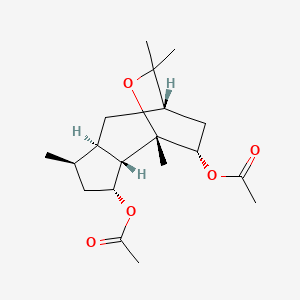

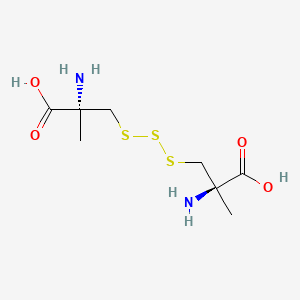


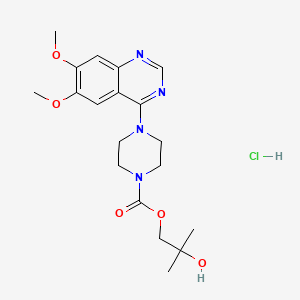
![(2S)-2-[[(2S)-2-aminohexanoyl]amino]-N-[(2S)-1-[[(2S)-1-[[(2S)-1-[[(2S)-1-[(2-amino-2-oxoethyl)amino]-3-(1H-indol-3-yl)-1-oxopropan-2-yl]amino]-5-(diaminomethylideneamino)-1-oxopentan-2-yl]amino]-1-oxo-3-phenylpropan-2-yl]amino]-3-(4H-imidazol-4-yl)-1-oxo](/img/structure/B1673405.png)
![N-[(3-Hydroxypyridin-2-Yl)carbonyl]glycine](/img/structure/B1673407.png)
